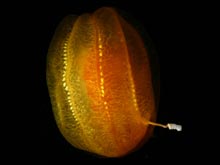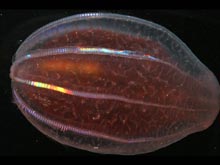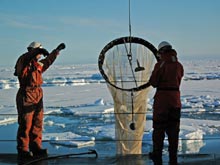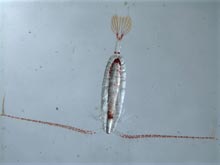
Aulococtena is the size and color of an orange and has two tentacles that are white, thick, unbranched and very sticky. This species has been encountered from 350-1100 meters deep on this expedition. Click image for larger view.
The ctenophore, Beroe cucumis , is specialized to eat other ctenophores. Click image for larger view.
Surprises from Comb Jellies in the Arctic
July 19, 2005
Jenny Purcell
Western Washington University
Shannon Point Marine Center
The comb jellies, also known as ctenophores (meaning "comb bearers"), have provided us with a wealth of new and interesting information during our cruise. Comb jellies are not true jellyfish; unlike jellyfish, they do not sting. These animals are among the most poorly known in the world's oceans because they have extremely fragile bodies. Traditional sampling methods involving plankton nets and formalin preservation destroy their delicate bodies. Some species are so delicate they pour like liquid out of our collecting jars! To overcome these sampling problems, we are observing and collecting ctenophores by SCUBA diving in the surface waters and using an ROV in deep waters down to 2800 m. We are finding ctenophores living at all depths, from the surface to the deep ocean bottom.
There is a shallow-dwelling community of jellies that occupies only 1% of the total water column depth. This community includes the ctenophore, Mertensia ovum , which feeds with sticky tentacles on large copepods in the top 20 meters of the water column. Mertensia is a robust species known throughout Arctic waters. During our 2002 Arctic cruise, I had been impressed with the abundance of Mertensia near the surface because I didn't expect any animals to be abundant in these waters of supposedly low productivity. Also feeding on near-surface copepods is the ctenophore, Bolinopsis infundibulum , which catches prey inside large, translucent lobes. Bolinopsis is extremely fragile, and its biology was poorly studied in the Arctic until now. The Coast Guard SCUBA divers have collected numerous specimens of these two species for gut content analysis, and digestion and respiration rate experiments by pelagic team scientists. Specialized plankton net sampling is also allowing us to determine the abundance of ctenophores, and traditional sampling is allowing us determine the abundance of their copepod prey. From these data, we will estimate the importance of ctenophore predation on the populations of large copepods. Bowhead whales prefer to eat these same copepods, therefore jellies and bowheads may compete for the same food resources in surface waters of the Arctic.
The shallow ctenophore community also includes two specialized predators. The ctenophore, Beroe cucumis , eats only other ctenophores. At our Arctic locations, Beroe has a bright red gut, perhaps caused by eating the red-tentacled Mertensia . The second specialist found was previously known only in Antarctica and the eastern Arctic; Dryodora gladiformis eats only planktonic tunicates known as larvaceans. Finding such restricted diets is surprising in animals that cannot locate their prey using any specialized sensory organs (eyes, ears or noses) in an environment where prey are widely scattered in a three-dimensional water column.
A "live net" is deployed in Arctic waters. Live net sampling allows us to determine the abundance of ctenophores and other Jellies. Click image for larger view.
Calanus hyperboereus (up to 7mm in length) is a preferred food of both ctenophores and Bowhead whales. Click image for larger view.
Deeper in the water column, three types of ctenophores previously unknown to Arctic waters are being found. Around 300 m depth, we are seeing several ctenophores with teardrop-shaped tentacle branches. At 1375-2625 m depth, we are seeing ctenophores with dark purple guts and finely-branched tentacles that have been observed in other waters, but have not been formally described and named. We are collecting specimens of both species for photographic records, and taxonomic and molecular identification.
From 350-1100 m, we are seeing a ctenophore species previously described deep in Monterey Bay, California, and the North Atlantic. This amazing animal, Aulacoctena , is the size and color of an orange. I like to think of it as the 'Sunkist' ctenophore. It has two tentacles that are white, thick, unbranched and very sticky; during collection the tentacles managed to stick strongly to the ROV. We speculated about what such an unusual ctenophore might eat; other tentaculate predators with similar tentacles feed on large, active prey. Few large animals, however, live at such great depths in the mid-water realm. Finding the answer to this mystery was not expected, but the very first specimen collected regurgitated the remains of a meal in the container - mainly a partly digested nemertean worm. We had seen and collected this large, orange worm at similar depths. For me, this discovery is the highlight of the cruise because much of my research is devoted to measuring the diets and predation rates of jellies in various locations.
We expected to see some known jellyfish species hovering just above the ocean bottom, but we were startled when a completely unknown ctenophore species came into view! We collected the ctenophore and hope to obtain more video records and specimens on upcoming ROV dives. With luck, we will also be able to discover what types of animals this unknown species is feeding on!
Sign up for the Ocean Explorer E-mail Update List.



































